Cardno’s ISO 19650 Implementation with 12d Synergy’s Common Data Environment (CDE)

Watch: ISO 19650 and 12d Synergy with Cardno
ISO 19650 Overview
ISO 19650 is a series of international standards which define a common unified framework for the effective collaborative production and management of information across the full lifecycle of a built asset using building information modelling (BIM). The standards establish a structured process for the effective creation, coordination, and delivery of information with the aim of ensuring the right people work on the right information at the right time. Ultimately, so built environment projects are delivered on time, within budget, and to standard. ISO 19650 can benefit all stakeholders throughout the asset’s lifecycle, including clients, consultants, contractors, asset owners, and operators.
To learn more about ISO 19650, read our comprehensive guide on the series here.
ISO 19650 in Context
It’s important to understand that ISO 19650 and the information management does not exist in isolation, but rather within the greater context of your asset management and business systems. “ISO 19650 is only a piece of the puzzle in the overall context of an organisational management structure”, Blake explains. The diagram below published in ISO 19650-1 illustrates this relationship. ISO 19650 concerns the delivery phase of assets and involves the creation of a project information model (PIM) in accordance with the project information requirements (PIR) and the exchange information requirements (EIR). Upon completion, elements of the PIM may be transferred to the asset information model (AIM), along with the information archive to enable the ongoing operation and maintenance of the asset.
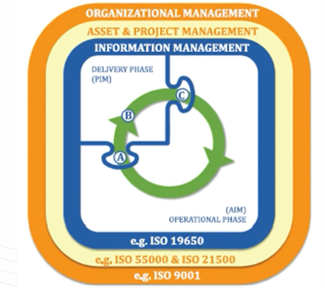
Source: UK BIM Alliance Guide
ISO 19650 and the Common Data Environment
To enable the information management process, a central repository is needed to collect, manage, and disseminate information with the appropriate parties. This is where a common data environment or CDE comes in, it’s the technology that enables the ISO 19650 information management process. Blake explains: “Essentially a CDE is a single point of truth environment, an area where we have assurance that the information we use is current, is relevant, and can be applicable to tasks and activities on a project. ISO 19650 helps us add colour to the picture, highlighting how to track information in this single point of truth in terms of its state.”
To learn more about the Common Data Environment (CDE), read our CDE Guide here.
The CDE Workflow
The CDE is governed by the CDE workflow, a structured process outlines in ISO 19650-2 that controls the flow and management of information between parties during the whole asset lifecycle. Part A, B, and C (mentioned before) become the states in a CDE workflow: Work in Progress (WIP), Shared, Published, with a fourth state, Archived. These states are illustrated in the following image.
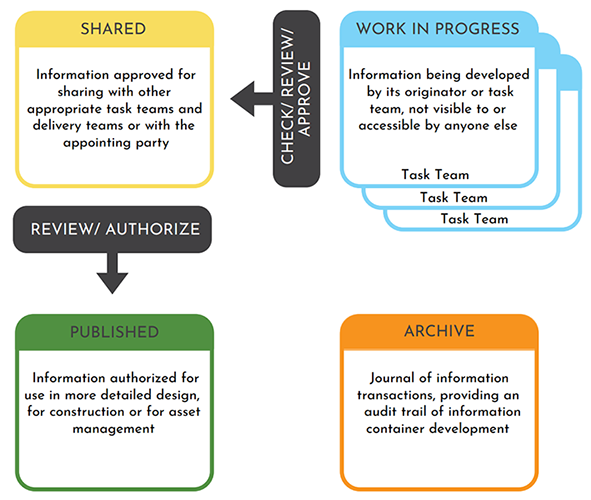
Source: ISO 19650-1:2018 (originally from BS 1192:2007)
Work in Progress
Blake says: “In the WIP state we have task teams or siloed activities which could be broken down by discipline. These tasks happen in isolation simply because the development of that information, whether that be a document, a model or otherwise, still requires input only at that disciplinary level and is not approved for sharing. The value of input from the wider team cannot yet be realised. And so, the siloing of tasks to potentially a discipline therefore makes sense. Once that information is developed, reviewed, and approved, can we then share with other task teams for coordination.”
Shared information is information that has been verified to be shared with other task teams or disciplines. It is read-only and must be the most current approved revision of the information container, that is a file, model, document or dataset.
Published
Published information is information that has been issued to the client (appointing party) and accepted as an information deliverable. It is again read-only information and must be the most current authorised revision of the information container.
Archived
Once all delivery milestones have been met, the information is aggregated and archived to enable the ongoing operation and maintenance of the asset. This is a journal of information transactions, providing an audit trail or file history of the information container’s development.
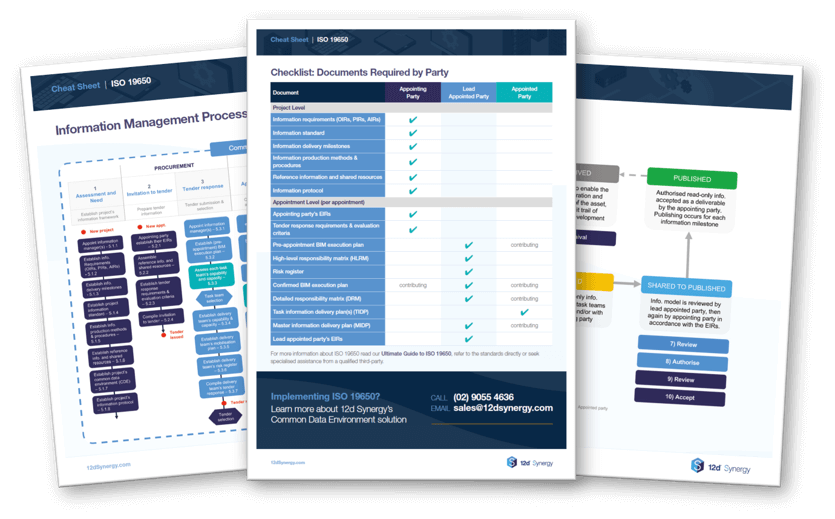
ISO 19650 in 12d Synergy
To achieve their ISO 19650 digital transformation, Cardno are utilising 12d Synergy as their common data environment. The collaborative platform was already being widely utilised by Cardno for document and data management, with over 400 users. Since then, the company has sought to configure the system to meet the requirements of ISO 19650. There are several features within 12d Synergy that Cardno use to benefit from ISO 19650. This is detailed below.
Folder Structure & Job Templates
This feature allowed Cardno to define and enforce the use of a standardised job structure. An ISO 19650 compliant folder structure was created based upon the 4-stage CDE workflow. This folder structure is illustrated in the following image.
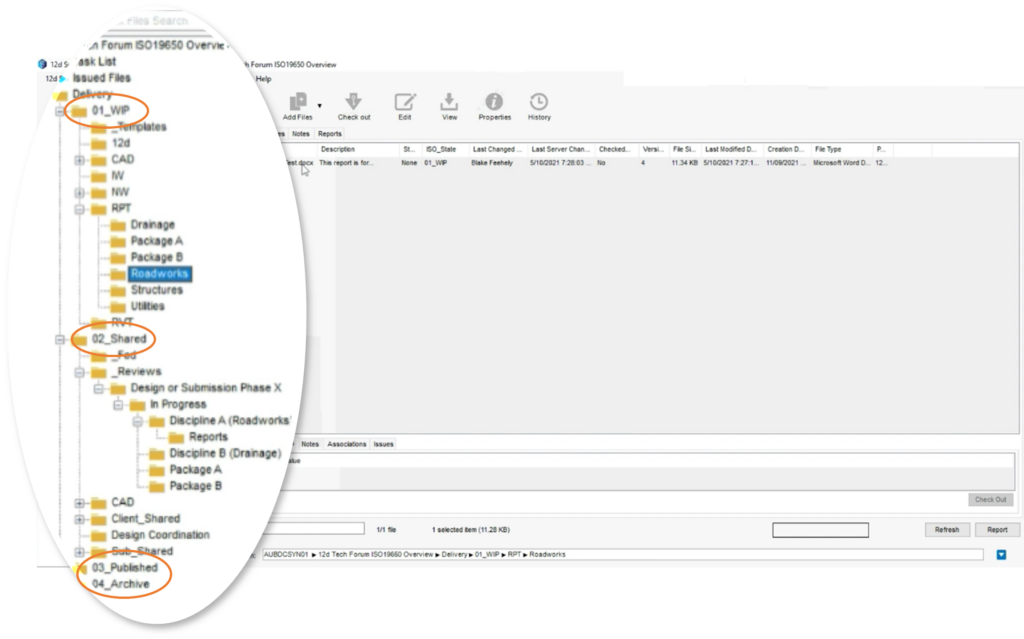
Roles & Permissions
ISO 19650 requires access to be controlled accordingly. 12d Synergy can be used to control access of information to only authorised parties through the feature Roles & Permissions. For instance, WIP information is only accessible and editable by the task team directly responsible for its projection. This prevents other task teams referencing draft information that isn’t ready to be shared and coordinated. Clients or other project partners can also be given read-only access to the Shared and Published folder.
Naming Conventions
ISO 19650 requires all information containers to have a unique container ID, so all files must have their own unique file name. In 12d Synergy, a Naming Convention can be applied to all files and data, that is a rule on how to name the file. This ensures correct practices are used by all parties across the project and information can be easily search for and retrieved.
Attributes
ISO 19650 requires files to use a consistent classification codes and be clearly identifiable by its state and status. In 12d Synergy this can be defined using File Attributes. Various attributes or meta-data can be assigned to files which gives more background information for the user or team member. So, a design can have a status code (indicated the permitted user) and any classification codes (the categorisation of information regarding a standardised system) selected when it’s added to the CDE. These attributes can be personalised to anything you want to add as extra meta-data to the information container.
Version Control
ISO 19650 requires information to be produced once and re-used multiple times. The Check-in Check-out feature ensures there is only one single source of truth. Once a file is check-out of 12d Synergy, no one else can make amendments to the file, ensuring there are no double ups or data corruption. In conjunction, the Version Control & Change History function automatically maintains an auditable record of information. The correct or latest version of files can be utilised for information creation and coordination. Again, this is valuable for ISO 19650 as it reduces errors and rework, while improving inter-disciplinary collaboration for all team members during the WIP state.
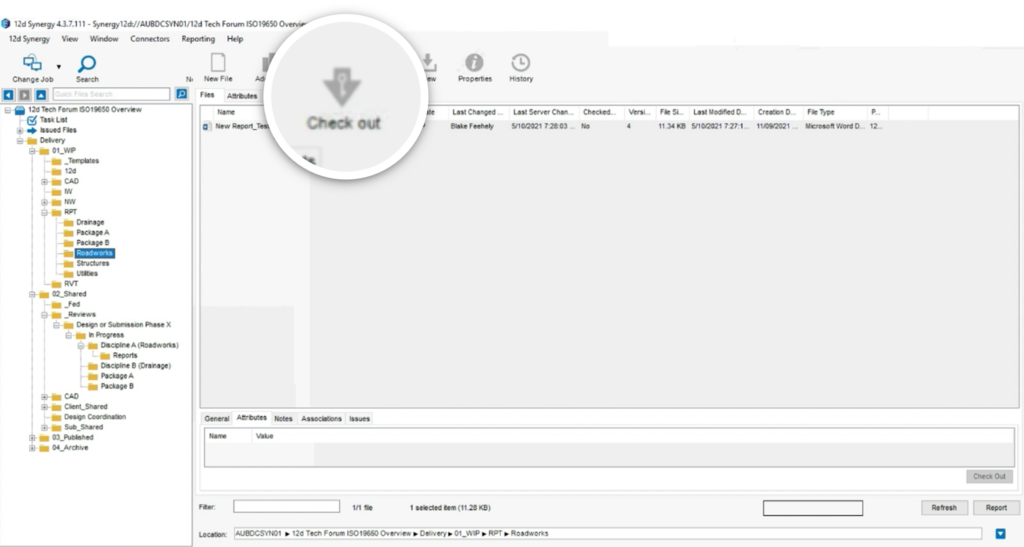
Webdrop & Publishing
This function is for informally sending and receiving data externally of the CDE. This function in 12d Synergy means you can review files with your respective task teams. Linking this to ISO 19650, this function can be utilised when moving a file to the Shared state of the CDE workflow.
Issuing & Transmittals
This is feature is important for issuing files to clients, there are date and time stamps for each issue so everything is recorded for future reference. In 12d Synergy, you can easily send files to clients for reviews and approvals. In terms of ISO 19650, this function is helpful when a file is ready to be Published and moves to that state.
“In my opinion, 12d Synergy is synonymous with a CDE or a common data environment.”
Future Enhancements
Cardno plan to utilise more functions with 12d Synergy, like Workflows and Tasks to provide further efficiency to the ISO 19650 configuration. Workflows enable system admins to define structured processes in the creation and management of information. These processes can follow rules to provide some automation for a job or project. Tasks can provide tracking of all future actionable items for each team member. Together, these features can add additional support in information management for any built asset.

Learn More about ISO 19650
We have additional resources available if you would like more details and information explaining ISO 19650.
- Read our comprehensive ISO 19650 Guide
- Read our Guide to the Common Data Environment (CDE)

